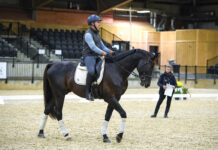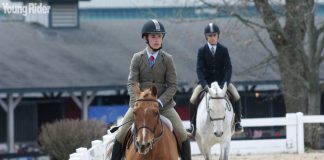Riders who eagerly practice lateral exercises, like the giravolta, usually have good intentions for the outcome, such as a looser horse, but too often end up creating problems they did not count on.

The benefit of this month’s exercise comes from keeping the shoulder mobile. This reduces most horses’ tendency to brace or tighten through their shoulders and lock their back.
By keeping a walking rhythm with the front feet through the turn, the horse keeps his shoulders loose and torso more lifted, helping him use his body correctly.
We call this exercise the giravolta, sometimes translated from classical dressage texts as “to twirl” or “to spin around.” Historically, it was used when stepping the horse in a tight circle around pillars in the center of the arena prior to more highly collected work.
The giravolta introduces lateral work to the horse while ensuring good form and minimal strain or soreness. It also serves as a useful tune-up any time a horse gets compromised in his balance and rhythm when doing more complicated moves, such as shoulder-in or haunches-in.
How to Cue the Giravolta with Your Horse
The cues for the giravolta follow three-part sequence. Let’s assume you’re asking the horse to move away from your right leg:
- First, ask to see your horse’s right eye with a light vibration on the right rein. Wait for him to swivel his head to the right.
- Next, shift slightly more weight or pressure into your right seatbone while lengthening your right leg.
- Lastly, if your horse is not already moving away from that weight shift, close your right leg rhythmically in time with his steps (on-off, on-off).
Riding the Giravolta
- Ride in an active working walk up the middle of your arena, or in any open space.
- Gently half-halt with your seat and back to downshift to a slower gear. Ask your horse to almost stop, but keep his feet inching forward.
- As soon as he responds to this downshift, apply the three-part cue described above.
- Make sure his right hind leg steps all the way across his left hind leg, forming an “X.”
- Maintain a little forward momentum in your turn so that your horse’s front feet keep marching incrementally ahead. Imagine his front feet walking around a tiny circle while his back feet follow a very large circle.
- After you have executed a 180-degree change of direction, ride straight ahead and resume the normal energy of the walk.
Continue repeating the giravolta in both directions interspersed with riding short straight lines.
This article about the giravolta originally appeared in the May 2018 issue of Horse Illustrated magazine. Click here to subscribe!






